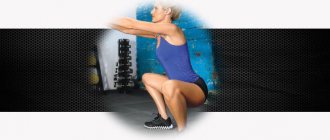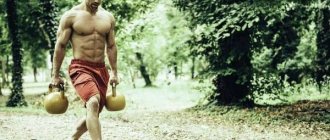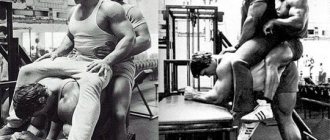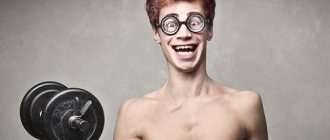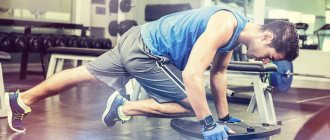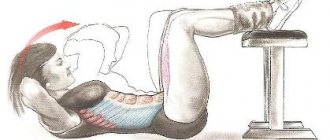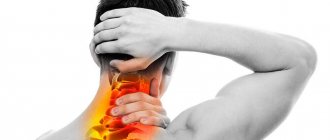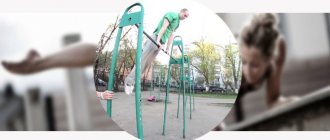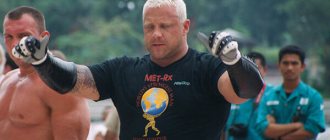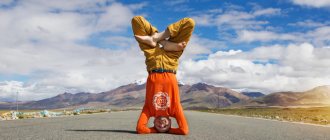Do you want to have harmoniously muscular legs? If you are serious about working on this part of the body, you need to pay more attention to the hamstrings.
A lot is known about the arm biceps, but few know how to pump up the hamstring biceps, and only a few can name truly working exercises for the hamstring biceps for the gym. Our expert, international master of sports, Alexey Hernandez Ortega, will tell you all the details of working out this biceps muscle.
Now that you are serious about getting a perfect body, you need to understand the importance of leg training. Imagine a guy showing off his broad shoulders on the beach with his stick legs peeking out of his shorts. It's an unsightly picture, isn't it?
To make your leg muscles grow, you need to put in a lot of effort. Usually, when planning a leg workout, guys start by working on the quadriceps. After a lot of intense exercises on the quadriceps, they move on to the thighs already tired. With the last of their strength, having done 1-2 sets of hamstring exercises, they consider that the task is completed. You know what? With this approach, you will never build powerful thighs! If you are serious about working on your body and want to achieve harmoniously developed leg muscles, pay more attention to your hamstrings!
In this article, you will learn everything about hamstrings: muscle anatomy, recommended training schedule, best exercises, and get a workout from a pro!
Bodymaster.ru recommends Training Plans:
The hips are involved in many daily activities such as walking, running, jumping, and they also control some body movements. For example, when walking, they act as an antagonist for the quadriceps and inhibit knee extension. The long head of the biceps extends the thigh when walking, and both heads together bend the knee and rotate the lower leg laterally. The semitendinosus and semimembranosus muscles are involved in hip extension when the body is stationary. They also provide internal rotation of the shin when the knee is bent.
Medial thigh muscle groupmedial thigh muscle group
The muscles of the medial group include the gracilis, pectineus and adductor (long, short and major) muscles. The main function of the muscles of this group is adduction of the thigh, which is why they are called adductors. They reach a strong development in humans in connection with erect perception. These muscles begin on the outer surfaces of the ischium and pubis, near the obturator foramen. The origins of the muscles occupy a relatively large surface - from the level of the pubic tubercle to the ischial tubercle. The place of attachment of the adductor muscles is even more extensive - from the lesser trochanter to the medial epicondyle of the femur. The general direction of the muscle bundles is oblique, they pass from front to back, from top to bottom to the linea aspera of the thigh, which serves as the attachment point for most of these muscles.
Gracilis is a flat, long muscle; located superficially along the entire medial surface of the thigh. It begins with a short tendon from the lower half of the pubic symphysis and from the lower branch of the pubic bone. In the lower third of the thigh, the muscle belly is located between the sartorius and semimembranosus muscles. The gracilis tendon attaches to the medial surface of the upper body of the tibia and is involved in the formation of the superficial pes anserine. The muscle adducts the thigh; bends the lower leg, simultaneously turning it inward.
The pectineus muscle is a short, flat muscle that originates from the crest and superior ramus of the pubis. It is attached by a flat thin tendon to the area located between the posterior surface of the lesser trochanter and the rough line of the femur. The muscle is involved in adduction and flexion of the hip.
The long adductor muscle is triangular in shape, located medially and inferiorly to the pectineus muscle, covering the front of the short adductor muscle and the upper bundles of the adductor magnus muscle. It begins as a thick tendon on the outer surface of the pubic bone (between the crest and the pubic symphysis). Passing downward and laterally, it continues into a thin tendon, which is attached to the medial lip of the linea aspera of the femur between the insertions of the adductor magnus muscle and the vastus medialis muscle. The muscle adducts the thigh, simultaneously bends and rotates it outward.
The adductor brevis muscle is a thick, triangular-shaped muscle; begins on the outer surface of the body and the lower branch of the pubic bone. Located behind the pectineus muscle and adductor longus muscle. Moving downwards and laterally, the muscle widens significantly and is attached by short tendon bundles to the line aspera on the body of the femur. The muscle adducts the thigh and is involved in hip flexion.
The adductor magnus muscle is thick, triangular in shape, the largest among the muscles of the medial thigh group. Starts from the ischial tuberosity, the branch of the ischium and the lower branch of the pubis; is attached along the entire length of the medial lip of the linea aspera. The adductor magnus muscle is located behind the short and long adductor muscles. Adjacent to it are the semitendinosus, semimembranosus and long head of the biceps femoris muscles. The fascicles of the proximal part are oriented almost horizontally, passing from the pubis to the upper part of the thigh; the bundles of the most distal part of the muscle are directed vertically downwards - from the ischial tuberosity to the medial epicondyle of the femur. The tendon of the adductor magnus muscle at the point of attachment to the “adductor” tubercle of the medial condyle of the femur limits an opening called the tendon gap. Through it, the femoral artery passes from the adductor canal on the thigh into the popliteal fossa. The muscle is the strongest adductor muscle of the thigh; the medial muscle bundles, originating from the ischial tuberosity, are also involved in hip extension.
When to train hamstrings
You can swing your hips in one of three ways. One week of leg training, start with the hamstrings, the next week, start with the quadriceps. You can also divide the program: biceps and quadriceps in the morning, other muscle groups in the evening. Or set aside a separate day for the back of the thigh. If you are looking to significantly increase your hamstrings, the latter option will be preferable. It's difficult to dedicate a day to just one muscle group, so you'll likely have to work on your legs as a whole. In this case, choose the first or second option.
Warm-up and stretching
And the last thing you should know before pumping up your hamstrings is warming up and stretching the muscles. Start with 10-15 minutes of walking on a treadmill or cycling. Then stretch and relax. Stretch not only your legs, but your entire body, including your core. Stretching will help you avoid injury and work harder. Stretch your muscles between sets and at the end of your workout.
How to build strong and elastic hamstrings
- Biceps are not outsiders
. Too often I see guys saving a couple sets of leg biceps for the end of the workout. They consider it a burden. But biceps strength is very important for the normal functioning of your knees, and your athletic performance largely depends on it. So train them as seriously as you train the rest of your body. - The Romanian deadlift is the best exercise
. It is similar to a deadlift with straight legs, but is performed with slightly bent knees. Maintain a natural arch in your lower back. The bar should move almost close to your hips and knees. If it is moved too far forward from you, then a lower back injury is possible. Lower the bar slowly and under control, raise it slightly faster with a slight acceleration. - Stretch your biceps thoroughly after every workout
. Poor elasticity of these muscles can lead to injury, and good stretching will help them grow. - Do more reps on leg curls
. Although it is better to give preference to the “Romanian” deadlift, if you want to supplement the training with leg curls, then do at least 10 repetitions. I've always said that legs respond better to higher reps, but this is especially true for leg curls at the end of a workout. - Contract your hamstrings
. Each time between sets, take time to contract your leg biceps, just as you would your arm biceps or chest muscles. They will respond to this by increasing in size and density. Many people forget about this. - Try combining back and leg biceps training
. I have always found this combination to be effective. Since we train these muscle groups mainly in an incline position, they seem to complement each other. I always liked this “duet”. - Perform exercises at different speeds
. Although a fast rise and slow descent is preferred, vary the speed occasionally. I have found that such changes have a significant stimulating effect. Work slowly one day, fast the next. - When bending your legs, change the position of your feet
. Pointed or raised toes can have different effects on biceps flexion performance. In the first case, a greater contraction is felt in the upper part of the biceps, and in the second - in the lower part. - Tighten and relax your calf muscles for variety
. Many people don't think about this and constantly tense their calf and other calf muscles when bending their legs. It's tradition, but try to relax them. The forced reduction in working weight and difficulty in movement will show you how much your calves are helping your biceps curl. Try to isolate them. - Walking lunges also load the hamstrings
. Many consider them to be an exercise exclusively for the quadriceps. This is partly true, but if you take a wide step and go down deep enough, then the biceps are included in the work. Along with Romanian deadlifts, this is one of my favorite exercises for the biceps and glutes. Make sure your quads are fully recovered from their own workout, because they will have to work too. Hardgainer.RU
| The permanent address of this article on the Internet is: https://www.hardgainer.ru/hard2.view1.page12.html |
| Like |
Latest updates in this section of Hardgainer.RU:
- Four myths about bench presses or how to improve your bench press results
- The Six Best Exercises for Six-Pack Abs
- How to learn to do pull-ups. World records in nominations. Part 2
- How to learn to do pull-ups. Part 1
- Presses in the simulator to build chest muscles
The best exercises for the hamstrings
Now you are ready to work with the hardware. Start with deadlifts. The first set is a warm-up set, perform it with a bar without weight. To avoid worrying about your grip, use wrist straps.
Deadlift with a barbell on straight legs
Workout Features
It is important to create a training program for home training and the gym, which includes the basic elements, as well as the best exercises for training the biceps muscle. This is done because most exercises for training the hamstrings also involve the glutes, as well as the quadriceps. Thus, this approach will help to develop the hips correctly and with better results, without pumping only one area.
To train your legs with high efficiency, you need to use strength training. Based on this principle, hamstring exercises at home are not easy to do. Repeated squats or lunges performed without strength training will not show the same results as their best hamstring variations in the gym.
Before training for the legs and hamstrings, it is important to warm up the muscles; to do this, work out on an incline for 15 minutes, jog or walk at a brisk pace - this will help avoid injuries associated with sprains.
Bodymaster.ru recommends Fitness Trainers:
Stand straight with your feet shoulder-width apart or narrower. Keep your knees slightly bent and stationary throughout the hamstring exercise. This is the starting position. As you exhale, lower the barbell to your feet by bending at the waist. Keep your back straight. Continue lowering yourself as if you were about to pick up an object from the floor until you feel a stretch in the back of your thigh.
As you inhale, return to the starting position with a straight back, straightening your hips and waist. Throughout the entire exercise, your gaze is directed forward or upward. When your head is lowered, there is a lot of pressure on your neck and back, which can lead to injury.
As a warm-up, do two sets of 20 reps with an empty bar or light weight. Next - two working sets of 15-20 repetitions. If you have back problems, start with leg curls in the machine.
Leg Curl
With this exercise we bring double benefits to our legs: we pump up the hamstrings and at the same time work the buttocks.
Place the strap over your foot. One leg is the supporting leg, the other is the working leg. Your back is always straight, do not strain it. This is the starting position. Don't lose your balance. As you inhale, bend your working leg and lift it towards your buttocks, concentrating on contracting the back of your thigh. Slowly return to the starting position and repeat, extending your leg as you exhale.
After the required number of repetitions, perform the exercise on the other leg. Do three working sets of 15-20 reps on each leg and be sure to stretch the muscles at the end of the last set.
The next exercise is the most intense of the entire workout.
Leg bending on the simulator
Before doing leg curls, adjust the machine according to your height. Lie face down and position yourself so that the bolsters are just below your calves. The body is pressed tightly to the bench, legs are extended. Hold the side handles of the exercise machine with your hands, turn your toes towards you. This is the starting position. As you exhale, bend your legs as much as possible without lifting your hips off the bench and pause for a moment at the top of the movement. As you inhale, return to the starting position.
While performing this hamstring exercise, do not twist your head to the sides or lift it, so as not to unnecessarily strain your neck and back. Just look down and focus on tightening your hamstring muscles. Perform two sets of 15-20 repetitions. Rest between sets – 2 minutes.
After the second set, rest and perform a drop set of 50 reps. When you reach your limit, reduce the weight, wait five seconds and continue until you have done all 50 reps. Afterwards, take a few minutes to stretch and walk around the gym or on the treadmill before you leave.
The base is squats with a barbell on the shoulders, without it I simply cannot imagine training for the hips. Here's my version of the thigh program, which will fully load the hamstrings and make your butt work great!
Best Quadriceps Exercises After a Knee Injury
Good day to you, dear readers! Not everyone likes to train their legs, because it is so tiring and difficult. Meanwhile, we, as erect walking creatures, owe it to the leg muscles for the ability to move, sit down, stand up and climb stairs. This is especially true for the quadriceps, although you shouldn’t forget about the back of the thigh.
So weight training can be a great way to improve not only your appearance, but also your ease of movement! And in some cases, physical exercises for the quadriceps femoris muscle are simply irreplaceable, for example, during postoperative rehabilitation.
Exercises and nuances of quadriceps training
The knee joint is the most injured joint in our body. After all, it is constantly at work, experiences shock loads, and in sedentary people it suffers from a lack of nutrients.
Now about the exercises and nuances:
One of the most effective exercises for the quadriceps is squats. Stretching plays an important role in this.
Therefore, before you start squats, make sure that your muscles in your legs, buttocks and back are flexible enough. Otherwise, you won't be able to squat with proper form!
What tests can you use to determine your stretch marks? Watch the video:
The type of squats determines the load on the quadriceps. The extensors receive the greatest load in squats with a barbell on the chest. Then with the barbell on your back, but with a relatively vertical back. Use them in your programs
Many people don't know how deep to squat. There is no definite answer, since the amplitude depends both on the flexibility of the joints and the elasticity of the muscles, and on the condition of the knee and hip joints
Lunges are a variation of squats. They differ only in that the entire load in the repetition falls on one leg, and the quadriceps of the other thigh experiences a stretch. This exercise is an effective way to complete your front thigh workout.
At the end of your workout, perform a set of stretching exercises. It can consist of elements that you pick up from the video. But don’t try to repeat everything exactly like in this video. Start with the simplest exercises and small range of motion
Exercises for health problems
Not all sports are safe and allow you to control your body every second to avoid injury. For example, team sports, especially contact sports: hockey, football, rugby. Yes, this also happens in fitness, but, as a rule, due to violation of the basic rules of training!
To speed up the postoperative recovery process, a surgical procedure with minimal tissue trauma - arthroscopy - is often performed. After it, the patient can perform physical therapy the very next day. Then the patient is discharged, and further rehabilitation actions fall on his shoulders.
And this is where the main thing is not to harm yourself! It is necessary to return to training gradually, dividing the entire recovery phase into several parts.
Stage No. 1
The exercises are performed slowly, without weights, and often while sitting or lying down. The stage can be considered complete when joint mobility is restored by more than 60%.
Stage No. 2
Here the emphasis is on strengthening muscles and ligaments that may have been significantly weakened after injury and surgery. The exercises can still be done at home, but with light weights. You can use rubber bands or tubular expanders as weights.
Exercises for two stages are presented in the video.
Stage No. 3
Return to training in the gym. Joint mobility is restored, muscles and ligaments are strengthened. It's time to start training with iron!
Start your workouts with exercise machines. It is best to include leg extensions and flexions while sitting in a machine, and leg extensions and flexions on block exercise machines.
Be healthy!
In conclusion, I would like to draw your attention to the importance of regular training. They not only strengthen the muscles, but also provide nutrition to the joints. And in the postoperative period, recovery will be accelerated
And in the postoperative period, recovery will be accelerated.
This is interesting: Back lunges - exercise technique, how to perform back lunges to innervate the buttocks and hamstrings
Anatomical features of local muscles
The femoral biceps acts as an antagonist to the quadriceps, which bear static loads. The main task of this muscle is to bend the leg at the knee and extend it at the hip joint. The muscle is formed by long and short heads, which visually create a bulge on the back surface of the lower limb.
A negative specific feature of the femoral biceps is the ability to gradually shorten. This trouble is reflected in the inharmonious development of local structures. The consequence is often the development of pain during high elevation of straightened lower limbs and bending of the body in the frontal direction. To eliminate the problem and create an attractive leg architecture, you need to regularly perform exercises for the hamstrings, complementing strength training with quality stretching.
Training at home
In order to achieve tangible results in pumping this muscle at home, you can do exercises without using special equipment. To give the mentioned muscles work without having machines and a barbell, you should remember that you need a load when bending the legs, since curling the hamstrings is the only way to pump them up.
How it's done:
- Lying on your stomach, use a straight or inclined board. Inventive girls, for example, often use an ironing board for this purpose, one end of which can lie, say, on the armrest of a chair or sofa. Weights can be attached to the legs. The legs are bent and unbent, giving the muscles work.
- Lying on a regular bench (also face down), perform flexion or extension. The necessary force can be created by a partner who holds the legs of the training athlete.
- In the same position, force is created using pharmaceutical rubber. One end is tied to some kind of pipe, for example, and the other to the ankles. If this load is not enough, then you can use a backpack with a load or something else.
- Deep alternating lunges of the legs - the right leg is bent as much as possible, and the left leg is extended back, etc.
All these exercises will not replace the necessary exercise machine, but they will still work the biceps femoris muscles. Taking into account the individuality of goals, not everyone dreams of becoming Mr. Olympia, dreaming of a fantastic mass. Therefore, these exercises, which are done at home, are a way out for many. In any case, girls are more than satisfied with such training in most cases.
Isolation exercises
The maximum effect in training is achieved through exercises and elements that allow you to develop specific areas of the body. Now the important exercises for us are those aimed at the hamstrings. Let's consider performing hyperextension and leg bending in the simulator.
These hamstring exercises are performed in the gym and are not available at home.
Leg Curl
You need to do it lying down in the simulator, it’s easy to do, consider the following:
- lying on your stomach, legs pressed with a roll at the ankle;
- the torso is tightly pressed against the exercise machine and does not rise during exercise, otherwise it is fraught with damage;
- For the exercise to be effective, movements must be performed measuredly and with alignment;
- The lower limbs are tense, the knees are in a bent position when performing the exercise.
About the leg press technique in the simulator >>
Hyperextension
It trains the biceps femoris muscle well. When performing exercises, it is important to place the pads of the exercise machine under the quadriceps.
How to do it:
- back straight;
- hands on the chest, or you can put them behind the head;
- butt tense;
- slowly and measuredly bend forward.
